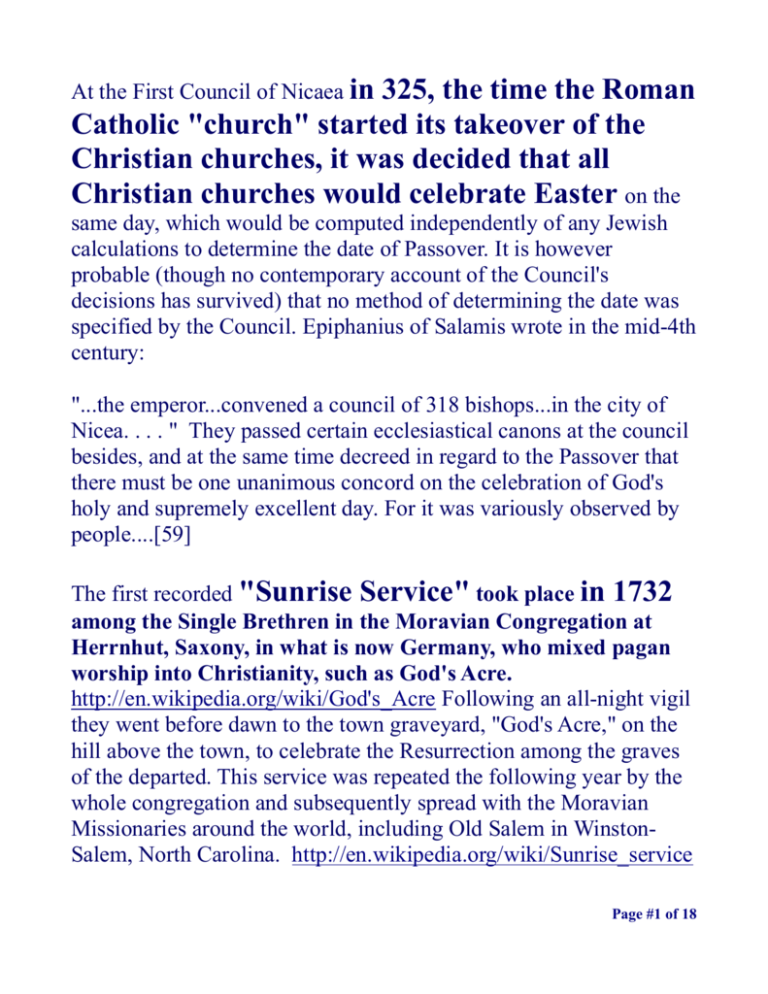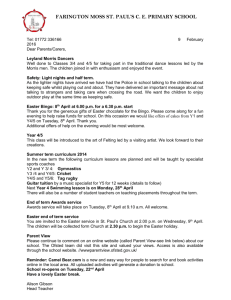At the First Council of Nicaea in 325, the time the Roman Catholic
advertisement

At the First Council of Nicaea in 325, the time the Roman Catholic "church" started its takeover of the Christian churches, it was decided that all Christian churches would celebrate Easter on the same day, which would be computed independently of any Jewish calculations to determine the date of Passover. It is however probable (though no contemporary account of the Council's decisions has survived) that no method of determining the date was specified by the Council. Epiphanius of Salamis wrote in the mid-4th century: "...the emperor...convened a council of 318 bishops...in the city of Nicea. . . . " They passed certain ecclesiastical canons at the council besides, and at the same time decreed in regard to the Passover that there must be one unanimous concord on the celebration of God's holy and supremely excellent day. For it was variously observed by people....[59] The first recorded "Sunrise Service" took place in 1732 among the Single Brethren in the Moravian Congregation at Herrnhut, Saxony, in what is now Germany, who mixed pagan worship into Christianity, such as God's Acre. http://en.wikipedia.org/wiki/God's_Acre Following an all-night vigil they went before dawn to the town graveyard, "God's Acre," on the hill above the town, to celebrate the Resurrection among the graves of the departed. This service was repeated the following year by the whole congregation and subsequently spread with the Moravian Missionaries around the world, including Old Salem in WinstonSalem, North Carolina. http://en.wikipedia.org/wiki/Sunrise_service Page #1 of 18 Along with Christmas celebrations, many Easter traditions ultimately became casualties of the various offshoots of the Protestant Reformation, being deemed "pagan" or "Popish" (and therefore tainted) by many Puritan movements – although there were some major Reformation Churches and movements (Lutheran, Methodist and Anglican for example), that chose to retain a reasonably full observance of the Church Year and many of its associated traditions. In Lutheran Churches, for example, not only were the days of Holy Week observed, but also Christmas, Easter and Pentecost were observed with three-day festivals (the day itself and the two following). Among many Reformation and Counter-Reformation traditions, however, things were very different, with most Anabaptists, Quakers, Congregational and Presbyterian Puritans, regarding such festivals as an abomination.[77] The Puritans (Calvinist) rejection of Easter traditions was (and is) based partly upon their interpretation of 2 Corinthians 6:14-16 and partly upon a more general belief that if a religious practice or celebration is not actually written in the Old and/or New Testaments of the Christian Holy Bible then that practice/celebration must be a later development and cannot be considered an authentic part of Christian practice or belief - so at best simply unnecessary, at worst actually sinful. Some Christian groups continue to reject the celebration of Easter due to pagan roots and historical connections to the practices and permissions of the "Roman" Catholic Church.[78] Other "Nonconformist" Christian groups (Romans 12:2) that do still celebrate the event prefer to call it "Resurrection Sunday" or Page #2 of 18 "Resurrection Day", for the same reasons as well as a rejection of secular or commercial aspects of the holiday in the 20th and 21st centuries. Acts 12:3-4 3 And because he saw it pleased the Jews, he proceeded further to take Peter also. (Then were the days of unleavened bread.) 4And when he had apprehended him, he put him in prison, and delivered him to four quaternions of soldiers to keep him; intending after Easter to bring him forth to the people. Note: " . . . and delivered him to four quaternions of soldiers to keep him; . . ." Each quaternion consisted of four soldiers, so that they were in all sixteen. There were four parties of four each, corresponding to the four Roman watches; two watching in prison and two at the gates, and each party being on duty for the space of one watch. Acts 12, tells us that it was the evil King Herod, who was planning to celebrate Easter, and not the Christians. Easter- Intending after -rather, "after the Passover"; that is, after the whole festival was over. (The word in our King James Version is an ecclesiastical term of later date brought in by the Roman Catholic "church," and ought not to have been employed here). In my Holy Bible, there is a letter g attached to the word Easter, subscript, which is notated in the notes to mean "the Passover, during the days of unleavened bread". Page #3 of 18 The Greek word, which the translators changed to Easter in Acts: 12:4, (the only time Easter is mentioned in the whole of the Holy Bible) is the Greek word: pascha, which means: the Passover, the Passover supper or lamb Original Word: πάσχα, τό Part of Speech: Aramaic Transliterated Word (Indeclinable) Transliteration: pascha Phonetic Spelling: (pas'-khah) Short Definition: the feast of Passover, the Passover lamb Definition: the feast of Passover, the Passover lamb. The painting of eggs and tales of a rabbit who decorates and hides eggs are among the folk customs associated with the holiday Easter. Easter is nothing else than Astarte, (Ishtar) one of the titles of Beltis, the 'queen of heaven,' or 'lady of the gods' whose name, as pronounced by the people of Nineveh, was evidently identical with that now in common use in this country." Bêlit is a form of the Akkadian language word beltu or beltum, (meaning "lady, mistress") as used in noun compounds; it appears in titles of goddesses, such as bêlit-ili "lady of the gods", an Akkadian title of Ninhursag. The word bêlit appears in Greek form as Beltis (Βελτις), considered to be the name of the wife of the god Bêl. Astarte pron.: /æˈstɑrti/ (Ancient Greek: Ἀστάρτη, "Astártē") is the Greek name of a goddess known throughout the Eastern Mediterranean from the Bronze Age to Classical times. It is one of a number of names associated with the chief goddess or female divinity of those peoples.[1] She is found as Ugaritic ?ミホリ?ミホラ? ʻṯtrt ("ʻAṯtart" or "ʻAthtart"); Phoenician "ʻštrt" (ʻAshtart); and in Hebrew ( עעעעעAshtoret, Ashtoreth, singular, or Ashtarot, Ashtaroth, plural), and appears in Akkadian as ?メハヘ?メフモ D, the grammatically masculine name of the goddess Ishtar; the Page #4 of 18 form Astartu is used to describe her age.[2] The name appears also in Etruscan as ?ミフヘ ? ?ミフヤ?ミフロ? Uni-Astre (Pyrgi Tablets), Ishtar or Ashtart. "Astarte . . .and in Hebrew ( עעעעעAshtoret, Ashtoreth, singular, or Ashtarot, Ashtaroth, plural), . . ." 1 Kings 11:5 5For Solomon went after Ashtoreth the goddess after Milcom the abomination of the Ammonites. of the Zidonians, and 1 Kings 11:33 33Because that they have forsaken me, and have worshipped Ashtoreth the goddess of the Zidonians, Chemosh the god of the Moabites, and Milcom the god of the children of Ammon, and have not walked in my ways, to do that which is right in mine eyes, and to keep my statutes and my judgments, as did David his father. 2 Kings 23:13 13And the high places that were before Jerusalem, which were on the right hand of the mount of corruption, which Solomon the king of Israel had builded for Ashtoreth the abomination of the Zidonians, and for Chemosh the abomination of the Moabites, and for Milcom the abomination of the children of Ammon, did the king defile. Judges 2:13 13And they forsook the Lord, and served Baal and Ashtaroth. Judges 10:6 6And the children of Israel did evil again in the sight of the Lord, and served Baalim, and Ashtaroth, and the gods of Syria, and the gods of Zidon, and the gods of Moab, and the gods of the children of Ammon, and the gods of the Philistines, and forsook the Lord, and served not him. Page #5 of 18 1 Samuel 7:3 3And Samuel spake unto all the house of Israel, saying, If ye do return unto the Lord with all your hearts, then put away the strange gods and Ashtaroth from among you, and prepare your hearts unto the Lord, and serve him only: and he will deliver you out of the hand of the Philistines. 1 Samuel 7:4 4Then the children of Israel did served the Lord only. put away Baalim and Ashtaroth, and 1 Samuel 12:10 10And they cried unto the Lord, and said, We have sinned, because we have forsaken the Lord, and have served Baalim and Ashtaroth: but now deliver us out of the hand of our enemies, and we will serve thee. 1 Samuel 31:10 10And they put his armour in the house of Ashtaroth: and they fastened his body to the wall of Bethshan. Ishtar, Astarte, Ashtoret, Ashtoreth, singular, or Ashtarot, Ashtaroth, plural was connected with fertility, sexuality, and war. Astarte's symbols were the lion, the horse, the sphinx, the dove, and a star within a circle indicating the planet Venus. Pictorial representations often show her naked. She has been known as the deified evening star.[3] Ishtar was the goddess of love and war, above all associated with sexuality: her cult involved sacred prostitution;[2][3] her holy city Uruk was called the "town of the sacred courtesans"; and she herself was the "courtesan of the gods".[4] Ishtar had many lovers. She (Ishtar) was particularly worshipped at the Assyrian cities of Nineveh, Ashur and Arbela (Erbil).[4] Besides the lions on her gate, Page #6 of 18 her symbol is an eight-pointed star.[5] In the Babylonian pantheon, she "was the divine personification of the planet Venus".[4] http://en.wikipedia.org/wiki/Ishtar Astarte was accepted by the Greeks under the name of Aphrodite or, alternatively, Artemis. Aphrodite's cult in Greece was imported from, or influenced by, the cult of Astarte in Phoenicia. The island of Cyprus, one of Astarte's greatest faith centers, supplied the name Cypris as Aphrodite's most common byname. Aphrodite is also known as Cytherea (Lady of Cythera) and Cypris (Lady of Cyprus) after the two cult sites, Cythera and Cyprus, which claimed to be her place of birth. Aphrodite believed that myrtle, doves, sparrows, horses, and swans were sacred. The ancient Greeks identified her with the Ancient Egyptian goddess Hathor.[4] Aphrodite had many other names, such as Acidalia, Cytherea and Cerigo, each used by a different local cult of the goddess in Greece. The Greeks recognized all of these names as referring to the single goddess Aphrodite, despite the slight differences in what these local cults believed the goddess demanded of them. Wunderlich (R. Winston, tr.).The secret of Crete (1987:134) said that the Crete statues found, indicate the Snake goddess, was associated with Aphrodite. http://en.wikipedia.org/wiki/Aphrodite The snake goddess, was worshipped as the serpent is often symbolically associated with the renewal of life because it sheds its skin periodically. A similar belief existed in the ancient Mesopotamians and Semites, and appears also in the Hindu mythology.[10] The Pelasgian myth of creation refers to snakes as the reborn dead. However, Nilsson noticed that in the Minoan religion the snake was the protector of the house,[1] as it later Page #7 of 18 appears also in Greek religion.[11] Among the Greek Dionysiac cult it signified wisdom and was the symbol of fertility.[10] http://en.wikipedia.org/wiki/Snake_Goddess Other goddesses probably associated with the "snake goddess" are: The ancient Egyptian goddess Renenutet, who often appeared in the form of a hooded cobra.[citation needed] The Phoenician goddess Tanit, worshipped as a patron goddess of Carthage.[citation needed] The Indian snake goddess Manasa, literally meaning "of the mind", or "conceived in the mind", or "power of the mind" is the tutelary deity of snakes and fertility, worshipped mainly in Bengal an the eastern parts of India. The ancient gods of the pagans had many different names. While this goddess was called Astarte in Babylon, it appears on Assyrian monuments found by as Ishtar Layard in excavations at Nineveh (Layard's Nineveh and Babylon, page 629). Both were pronounced "Easter." Likewise, Beltis, or Bel (referred to in the Old Testament) also was called Moloch. It was for sacrificing to Moloch (I Kings 11:1-11, especially verse 7, where Moloch is called an abomination) and other pagan gods that the Eternal condemned Solomon, and rended away the Kingdom of Israel from his son. In the ancient Chaldean idolatrous Sun-worship, Baal was the sun god, Astarte his consort, or wife. Astarte was pronounced the same as Ishtar, or the English Easter. Says Hislop: "The festival, of which we read in church history, under the name of Easter, in the third or fourth centuries, was quite a different festival from that now observed in the Romish (and later the Protestant) churches, until Page #8 of 18 that time of the (third and fourth centuries) it was not known by any such name as Easter. IT WAS CALLED PASSOVER, and was very early observed by Christians. That festival agreed originally with the time of the Jewish Passover, when the Lord Jesus Christ of Nazareth was crucified. . . . That festival was not idolatrous, and was NOT preceded by Lent." Lent is a worship of Tammuz "T" the mark of Tammuz (Baal) worship . . . Ezekiel 8:14. www.alemattec.com/Baal worship, Babylonian worship by the Roman Catholic 'church'.htm Cassianus in the fifth century worte, "That the observance of the forty days (Lent) had no existence, so long as the perfection of that primitive Church remained inviolate." The Lord Jesus Christ of Nazareth observed no Lent. The Apostles and the early true Church of God observed no Lenten season. Then how did this observance originate? "The forty days' abstinence of Lent was directly borrowed from the worshipers of the Babylonian goddess Ishtar. Adonis was certainly based in large part on Tammuz. His name is Semitic, a variation on the word "adon" meaning "lord". "Women sit by the gate weeping for Tammuz, or they offer incense to Baal on roof-tops and plant pleasant plants. These are the very features of the Adonis legend: which is celebrated on flat roof-tops on which sherds sown with quickly germinating green salading are placed, Adonis gardens... the climax is loud lamentation for the dead god."—Burkert, p. 177. Women in Athens would plant "gardens of Adonis" quick-growing herbs that sprang up from seed and died. The Festival of Adonis was celebrated by women at midsummer by sowing fennel and lettuce, Page #9 of 18 and grains of wheat and barley. The plants sprang up soon, and withered quickly, and women mourned for the death of the vegetation god.[14] Adonis, in Greek mythology, is the god of beauty and desire, and is a central figure in various mystery religions. His religion belonged to women: the dying of Adonis was fully developed in the circle of young girls around the poet Sappho from the island of Lesbos, about 600 BC, as revealed in a fragment of Sappho's surviving poetry.[1] http://en.wikipedia.org/wiki/Adonis Dagan, also spelled Dagon, West Semitic god of crop fertility, worshiped extensively throughout the ancient Middle East. Dagan (Dagon) was the Hebrew and Ugaritic common noun for “grain,” and the god Dagan (Dagon) was the legendary inventor of the plow. His cult is attested as early as about 2500 B.C., and, according to texts found at Ras Shamra (ancient Ugarit), he was the father of the god Baal. Dagan (Dagon) had an important temple at Ras Shamra, and in Palestine, where he was particularly known as a god of the Philistines, he had several sanctuaries, including those at Beth- dagon in Asher (Joshua 19:27), Gaza (Judges 16:23), and Ashdod (1 Samuel 5:1–7). At Ras Shamra, Dagan was apparently second in importance only to El, the supreme god, although his functions as a god of vegetation seem to have been transferred to Baal by about 1500 B.C.. http://www.britannica.com/EBchecked/topic/149618/Dagan Page #10 of 18 The Church of the Nativity in Bethlehem . . . The Church of the Nativity is built over a cave that was originally a shrine to AdonisTammuz. The Church Father Jerome, reports that the holy cave was at one point consecrated by the heathen to the worship of Adonis-Tammaz, and a pleasant sacred grove planted before it, to wipe out the memory of Jesus. The Greek Ἄδωνις (Greek pronunciation: [ˈadɔːnis]), Adōnis was a borrowing from the Semitic word adon, "lord",[2] which is related to Adonai, one of the names used to refer to the God ( )עעעעעעעin the Hebrew Bible and still used in Judaism to the present day. Adōnis to the Syrian Adonis is Gauas[3] or Aos, to Egyptian Osiris, to the Semitic Tammuz and Baal Hadad, to the Etruscan Atunis and the Phrygian Attis, all of whom are deities of rebirth and vegetation.[4] http://en.wikipedia.org/wiki/Adonis Hadad (Ugaritic ?ミホト? Haddu) is a Northwest Semitic storm and rain god, cognate in name and origin with the Akkadian (Assyrian-Babylonian) god Adad. Hadad was often called simply Baʿal (Lord), but this title was also used for other gods. The bull was the symbolic animal of Hadad. He appeared bearded,[1][2] often holding a club and thunderbolt while wearing a bull-horned headdress.[3][4] Hadad was equated with the Anatolian storm-god Page #11 of 18 Teshub; the Egyptian god Set; the Greek god Zeus; and the Roman god Jupiter, as Jupiter Dolichenus. Baal, also rendered Baʿal (Biblical Hebrew עעע, pronounced [ˈbaʕal]), is a Northwest Semitic title and honorific meaning "master" or "lord"[1] that is used for various gods who were patrons of cities in the Levant and Asia Minor, cognate to Akkadian Bēlu. A Baalist or Baalite means a worshipper of Baal. "Baʿal" can refer to any god and even to human officials. In some texts it is used for Hadad, a god of the rain, thunder, fertility and agriculture, and the lord of Heaven. Since only priests were allowed to utter his divine name, Hadad, Ba‛al was commonly used. Nevertheless, few if any Biblical uses of "Baʿal" refer to Hadad, the lord over the assembly of gods on the holy mount of Heaven, but rather refer to any number of local spiritdeities worshipped as cult images, each called baʿal and regarded in the Hebrew Bible in that context as a "false god". The Baal cult provided the greatest and most enduring threat to the exclusive worship of Yahweh among ancient Israelites. From Babylon this mystery-religion, what would become the worship of Tammuz and /Dagan (Dagon), (Baal) spread to all the surrounding nations, as the years went on and the world was populated by the descendants of Noah. Everywhere the Page #12 of 18 symbols were the same, and everywhere the cult of the mother and child became the popular system. Adonis-Tammuz worship was celebrated with the most disgusting and immoral practices. Adonis, in Greek mythology, is the god of beauty and desire, and is a central figure in various mystery religions. His religion belonged to women: the dying of Adonis was fully developed in the circle of young girls around the poet Sappho from the island of Lesbos, about 600 BC, as revealed in a fragment of Sappho's surviving poetry.[1] Adonis is one of the most complex figures in classical times. He has had multiple roles, and there has been much scholarship over the centuries concerning his meaning and purpose in Greek religious beliefs. He is an annually-renewed, ever-youthful vegetation god, a life-death-rebirth deity whose nature is tied to the calendar. His name is often applied in modern times to handsome youths, of whom he is the archetype. Adonis is often referred to as the mortal god of Beauty. Additionally, the image of the "queen of heaven" with the babe in her arms was seen everywhere, though the names might differ as languages differed. It became the mystery-religion of Phoenicia, and by the Phoenicians was carried to the ends of the earth. Ashtoreth and Tammuz, the mother and child of these hardy adventurers, became Isis and Horus in Egypt, Aphrodite and Eros Greece, Venus and Cupid in Italy, and bore many other names in more in Within 1,000 years, Babylonianism had become the religion of the world, as they had rejected the Divine revelation of Jehovah God. distant places. http://en.wikipedia.org/wiki/History_of_Punic-era_Tunisia:_culture Where did all of the strange customs come from, which have nothing to do with the resurrection of the Lord Jesus Christ of Nazareth? "Ishtar", which is pronounced "Easter" was a day that commemorated the resurrection of one of their gods that they called Page #13 of 18 "Tammuz", who was believed to be the only begotten son of the moon-goddess and the sun-god. "The dead and resurrected god Tammuz (Sumerian Dumuzi), prototype of the Classical Adonis, who was the consort as well as son by virgin birth, of the goddess-mother of many names: Inanna, Ninhursag, Ishtar, Astarte, Artemis, Demeter, Aphrodite, Venus" (in Oriental Mythology: The Masks of God pp 39-40). Semiramis (sĕmĭr`əmĭs), mythical Assyrian queen, noted for her beauty and wisdom. She was reputed to have conquered many lands and founded the city of Babylon. After a long and prosperous reign she vanished from earth in the shape of a dove and was thereafter worshiped as a deity, acquiring many of the characteristics of the goddess Ishtar (pronounced Easter). The historical figure behind this legend is probably Sammuramat, who acted as regent of Assyria from 810 to 805 B.C. Semiramis (pronounced /səˈmɪrəmɪs/) was the legendary queen of King Ninus, succeeding him to the throne of Assyria. The name of Semiramis came to be applied to various monuments in Western Asia and Asia Minor, the origin of which was forgotten or unknown.[3] Nearly every stupendous work of antiquity by the Euphrates or in Iran seems to have ultimately been ascribed to her, even the Behistun Inscription of Darius.[4] Herodotus ascribes to her the artificial banks that confined the Euphrates[5] and knows her name as borne by a gate of Babylon.[6] However, Diodorus stresses that the Hanging Gardens of Babylon were built long after Semiramis had reigned and not in her time. Various places in Assyria and throughout Mesopotamia as a whole, Medea, Persia, the Levant, Asia Minor, Arabia and the Caucasus bore the name of Semiramis, but slightly changed, even in the Middle Ages, and an old name of the city of Van was Shamiramagerd. The indigenous Assyrians of Iraq, north east Syria, south east Turkey and north west Iran Page #14 of 18 still name female children Semiramis. Queen Semiramis proclaimed that Baal would be present on earth in the form of a flame, whether candle or lamp, when used in worship. Semiramis was creating a mystery religion, and with the help of satan, she set herself up as a goddess. Semiramis claimed that she was immaculately conceived. She taught that the moon was a goddess that went through a 28 day cycle and ovulated when full. She further claimed that she came down from the moon in a giant moon egg that fell into the Euphrates River. This was to have happened at the time of the first full moon after the spring equinox. Semiramis became known as "Ishtar" which is pronounced "Easter", and her moon egg became known as "Ishtar's" egg." Ishtar soon became pregnant and claimed that it was the rays (spirit, much like the Holy Spirit) of the sun-god Baal that caused her to conceive. The son that she brought forth was named Tammuz. Like Ishtar, the Greek Aphrodite and Northwestern Semitic Astarte were love goddesses who were "as cruel as they were wayward".[14] Donald A. Mackenzie, an early popularizer of mythology, draws a parallel between the love goddess Aphrodite and her "dying god" lover Adonis[15] on one hand, and the love goddess Ishtar and her "dying god" lover Tammuz on the other.[14] http://en.wikipedia.org/wiki/Ishtar Tammuz was noted to be especially fond of rabbits, and they became sacred in the ancient religion. Tammuz was believed to be the son of the sun-god, Baal. Tammuz, like his supposed father, became a hunter. Baal, whose father was Dagan (Dagon) was the sun god of the Canaanites and Phoenicians, whose worship spread to the ancient Jews. In the Bible, Baal is also known Page #15 of 18 as Beelzebub. The day came when Tammuz was killed by a wild pig. Queen Ishtar told the people that Tammuz was now ascended to his father, Baal, and that the two of them would be with the worshippers in the sacred candle or lamp flame as Father their father/husband Son and Spirit Queen, or Queen of Heaven. Ishtar, who was now worshipped as the "Mother of God and Queen of Heaven", continued to build her mystery religion. The queen told the worshippers that when Tammuz was killed by the wild pig, some of his blood fell on the stump of an evergreen tree, and the stump grew into a full new tree overnight. This made the evergreen tree sacred by the blood of Tammuz. She also proclaimed a forty day period of time of sorrow each year prior on the anniversary of the death of Tammuz. During this time, no meat was to be eaten. Worshippers were to meditate upon the sacred mysteries of Baal and Tammuz, and to make the sign of the "T" in front of their hearts as they worshipped, or on their foreheads. They also ate sacred cakes with the marking of a "T" or cross on the top. Every year, on the first Sunday after the first full moon after the spring equinox, a celebration was made. It was Ishtar's (Easter) Sunday and was celebrated with rabbits and eggs. Ishtar also proclaimed that because Tammuz was killed by a pig, that a pig (ham) must be eaten on that Sunday. The truth is that Easter has nothing whatsoever to do with the resurrection of our Lord Jesus Christ of Nazareth. We also know that Easter can be as much as three weeks away from the Passover, because the pagan holiday of Easter is always set as the first Sunday after the first full moon after the spring equinox. Some have wondered why the word "Easter" is in the the King James Bible. It is because Acts 12, tells us that it was the evil King Herod, who was planning to celebrate Easter, and not the Christians. Page #16 of 18 Acts 12:1-4 1 Now about that time Herod the king stretched forth his hands to vex certain of the church. 2 And he killed James the brother of John with the sword. 3 And because he saw it pleased the Jews, he proceeded further to take Peter also. (Then were the days of unleavened bread.) 4 And when he had apprehended him, he put him in prison, and delivered him to four quaternions of soldiers to keep him; intending after Easter to bring him forth to the people. The forty days of Lent, eggs, rabbits, hot cross buns, and the Easter ham have everything to do with the ancient pagan religion of Mystery Babylon. These are all antichrist activities! Satan is a master deceiver, and has filled the lives of well-meaning, professing Christians with idolatry. These things bring the wrath of God upon children of disobedience, who try to make pagan customs of Baal worship as Christian. These customs of Easter honor Baal, who is also satan, the devil, that old serpent. How many churches have "sunrise services" on Ishtar's day (Easter) and face the rising sun in the East? How many will use colored eggs and rabbit stories, as they did in ancient Babylon. This false worship is no joke, any more than Judgement day is a joke. Lent of forty days, 'in the spring of the year,' is still observed by the Yezidis or pagan Devil-worshippers of Koordistan, who have inherited it from their early masters, the Babylonians. Such a Lent was held by the pagan Mexicans, in honor of the sun. . . . Such a Lent was observed in Egypt (Wilkinson's Egyptians). This Egyptian Lent of forty days was held expressly in commemoration of Adonis or Osiris, the great mediatorial god." (The Two Babylons, by Hislop, pages 104 and 105, and Sabean Researches, by Landseer, p. 112). Page #17 of 18 Acts 17:30-31 30 And the times of this ignorance God winked at; but now commandeth all men every where to repent: 31 Because he hath appointed a day, in the which he will judge the world in righteousness by that man whom he hath ordained; whereof he hath given assurance unto all men, in that he hath raised him from the dead. www.alemattec.com/Roman Catholic 'church' created Islam, and many other false religions, Mormons, etc, and worships Baal, and Ties, and Illuminati Symbols_ Part 1.htm www.alemattec.com/Roman Catholic 'church' created Islam, and many other false religions, Mormons, etc, and worships Baal, and Ties, and Illuminati Symbols_ Part 2.htm www.alemattec.com/Roman Catholic 'church' created Islam, and many other false religions, Mormons, etc, and worships Baal, and Ties, and Illuminati Symbols_ Part 3.htm www.alemattec.com/Roman Catholic 'church' created Islam, and many other false religions, Mormons, etc, and worships Baal, and Ties, and Illuminati Symbols_Part 4.htm www.alemattec.com/'mother theresa,' complete fraud of the Roman Catholic 'church'. . .htm Paul (<:) Jesus first! www.Alemattec.com Page #18 of 18







